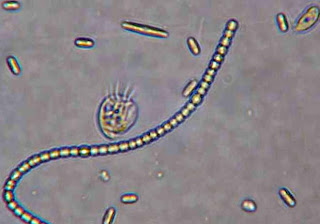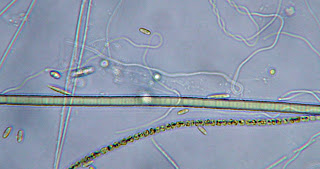

In this fifth and final observation of the MicroAquarium, Discomorpha, which is a flagellate and Anabeana, which is a diatom were identified (Pennak 1989). This observation was taken on November 12th. Decomposing green algae was observed, along with several other dead organisms, such as Phialina. Air bubbles and rapidly moving ciliates were still present in the aquarium. Amoebas, nematodes, and vortacella could still be seen, as well. No new pictures were taken with this week's observation. What organisms left in the aquarium were very small, and it was hard to get a well focused picture. The nematodes and the ciliates were the only organisms moving. The picture on the top is of Discomorpha, cyanobacteria, and diatoms, while the picture on the bottom contains the diatom, Anabeana. These pictures were taken during a previous observation.
Pennak RW. 1989. Freshwater Invertebrates of the United States Protozoa to Mollusca. New York (NY): John Wiley and Sons. p. 81.





